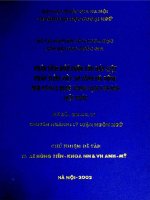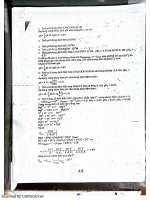Đề thi 20% phân tích diễn ngôn số 2
Bạn đang xem bản rút gọn của tài liệu. Xem và tải ngay bản đầy đủ của tài liệu tại đây (101.31 KB, 5 trang )
HANOI OPEN UNIVERSITY
MID -TERM TEST ON DISCOURSE ANALYSIS
FOR STUDENTS OF ENGLISH (No 2)
Subject Code: EN44
Full name: ………………………………...............
Date of birth: ………………………………...........
Group: …………………………………….............
BÀI GIẢI FULL
I. Prove that the following passage is a written text.
Organic farming and chemical fertilisers
A
The world’s population continues to climb. And despite the rise of high-tech
agriculture, 800 million people don’t get enough to eat. Clearly, it’s time to rethink
the food we eat and where it comes from. Feeding 9 billion people will take more
than the same old farming practices, especially if we want to do it without felling
rainforests and planting every last scrap of prairie. Finding food for all those people
will tax farmers’ – and researches’ – ingenuity to the limit. Yet already, precious
aquifers that provide irrigation water for some of the world’s most productive
farmlands are drying up or filling with seawater, and arable land in China is
eroding to create vast dust storms that redden sunsets as far away as North
America. “Agriculture must become the solution to environmental problems in 50
years. If we don’t have systems that make the environment better – not just hold the
fort-then we’re in trouble,” says Kenneth Cassman, an agronomist at the University
of Nebraska at Lincoln. That view was echoed in January by the Curry report, a
government panel that surveyed the future of farming and food in Britain. B
It’s
easy to say agriculture has to do better, but what should this friendly farming of the
future look like? Concerned consumers come up short at this point, facing what
appears to be an ever-widening ideological divide. In one corner are the technooptimists who put their faith in genetically modified crops, improved
1
agrochemicals and computer-enhanced machinery; in the other are advocates of
organic farming, who reject artificial chemicals and embrace back-to-nature
techniques such as composting. Both sides cite plausible science to back their
claims to the moral high ground, and both bring enough passion to the debate for
many people to come away thinking we’re faced with a stark choice between two
mutually incompatible options.
C
Not so. If you take off the ideological blinkers and simply ask how the world
can produce the food it needs with the least environmental cost, a new middle way
opens. The key is sustainability: whatever we do must not destroy the capital of soil
and water we need to keep on producing. Like today’s organic farming, the
intelligent farming of the future should pay much more attention to the health of its
soil and the ecosystem it’s part of. But intelligent farming should also make shrewd
and locally appropriate use of chemical fertilisers and pesticides. The most crucial
ingredient in this new style of agriculture is not chemicals but information about
what’s happening in each field and how to respond. Yet ironically, this key element
may be the most neglected today.
The passage provided is a written text. It contains coherent sentences and paragraphs,
presenting information and ideas related to organic farming, chemical fertilizers, and
sustainable agriculture. The text discusses the challenges of feeding a growing world
population, the need for rethinking farming practices, and the importance of environmental
sustainability in agriculture.
The text is structured with headings A, B, and C, indicating different sections or points
being addressed. Additionally, it uses formal language and specific terms like "high-tech
agriculture," "aquifers," "arable land," "genetically modified crops," "agrochemicals,"
"organic farming," "sustainability," "chemical fertilizers," "pesticides," etc., which
contribute to its written form and add clarity to the content.
Overall, the passage exhibits the characteristics of a written text, with a clear focus,
organization, and usage of formal language to present ideas and information related to
organic farming and agriculture...........
II. Find grammatical and lexical cohesive devices employed in this text.
Grammatical Cohesive Devices:
2
................................................................................................................................................ ..
..............................................................................................................................................
Pronouns: "it," "we," "that," "this," "they." These pronouns refer back to previously mentioned
concepts or ideas, helping to connect sentences and maintain continuity.
Connectors: "And," "yet," "But," "if," "so," "that." These words link sentences and clauses,
indicating logical relationships between them.
Demonstrative Adjective: "this." It refers to a specific concept mentioned earlier in the text.
Comparative Construction: "more than," "less," "better," "not just." These comparative phrases
establish contrasts and comparisons between different ideas or approaches.
Lexical Cohesive Devices:
Synonyms: "population" and "people," "farming" and "agriculture," "environmental problems"
and "environmental cost." The use of synonyms reinforces and clarifies the meanings of the
mentioned terms.
Repetition: The word "farming" is repeated throughout the text, emphasizing its importance and
relevance in the context of sustainable agriculture.
Specific Terminology: The text includes specialized terms such as "high-tech agriculture,"
"genetically modified crops," "agrochemicals," "organic farming," "chemical fertilizers,"
"pesticides," "soil," "ecosystem," etc., which contribute to the coherence and precision of the
content.
Descriptive Language: "friendly farming," "back-to-nature techniques," "moral high ground,"
"stark choice." These descriptive phrases add vividness and clarity to the discussion.
Overall, the text employs a variety of grammatical and lexical cohesive devices to connect ideas,
provide coherence, and facilitate the flow of information. These devices help readers understand
the relationships between different concepts and follow the logical progression of the argument
presented in the text.
3
................................................................................................................................................ ..
..............................................................................................................................................
................................................................................................................................................
..........
III. Translate the text into Vietnamese.
Nông nghiệp hữu cơ và phân bón hóa học
A. Dân số thế giới tiếp tục gia tăng. Và mặc dù nền nông nghiệp công nghệ cao đang phát
triển, 800 triệu người vẫn không đủ thức ăn. Rõ ràng, đã đến lúc suy nghĩ lại thực phẩm
chúng ta ăn và nguồn gốc của nó. Để nuôi 9 tỷ người, cần nhiều hơn những phương pháp
nông nghiệp cũ, đặc biệt là nếu chúng ta muốn làm điều đó mà khơng phá rừng hoặc
trồng đất hoang. Tìm thức ăn cho tất cả những người đó sẽ địi hỏi sự khéo léo của nông
dân và nhà nghiên cứu đến giới hạn. Tuy nhiên, đã có những khu vực ngầm cung cấp
nước tưới cho một số cánh đồng năng suất cao nhất thế giới đang cạn kiệt hoặc ngập
nước biển, và đất canh tác ở Trung Quốc đang bị xói mịn tạo ra những cơn bão cát rộng
lớn làm đỏ hồng hơn xa tận Bắc Mỹ. "Nơng nghiệp phải trở thành giải pháp cho các vấn
đề môi trường trong vịng 50 năm nữa. Nếu chúng ta khơng có hệ thống làm cho môi
trường tốt hơn - không chỉ giữ chỗ đó - thì chúng ta gặp rắc rối", Kenneth Cassman, nhà
nông học tại Đại học Nebraska tại Lincoln cho biết. Quan điểm này đã được lặp lại vào
tháng 1 bởi báo cáo Curry, một ban chính phủ nghiên cứu về tương lai nông nghiệp và
thực phẩm tại Anh.
B. Dễ dàng nói nơng nghiệp phải làm tốt hơn, nhưng hình mẫu nông nghiệp thân thiện
của tương lai nên trông như thế nào? Người tiêu dùng quan tâm đến điểm này đều cảm
thấy thiếu thốn, đối mặt với điều mà dường như là một khoảng cách tư tưởng ngày càng
rộng lớn. Ở một góc là những người lạc quan về cơng nghệ, họ đặt niềm tin vào cây trồng
biến đổi gen, agrochemical cải tiến và máy móc gia tăng thơng qua máy tính; ở góc kia là
những người ủng hộ nơng nghiệp hữu cơ, họ từ chối các hóa chất nhân tạo và chấp nhận
kỹ thuật trở về thiên nhiên như việc làm phân hữu cơ. Cả hai bên đều trích dẫn khoa học
hợp lý để bảo vệ những lập luận của họ là đúng đắn và cả hai đều đưa đủ đam mê vào
cuộc tranh luận để nhiều người suy ra rằng chúng ta đang đối mặt với một lựa chọn đơn
giản giữa hai lựa chọn khơng tương thích lẫn nhau.
4
................................................................................................................................................ ..
..............................................................................................................................................
C. Không phải vậy. Nếu bạn bỏ những lớp kính cận về tư tưởng và đơn giản chỉ hỏi làm
thế nào để thế giới có thể sản xuất đủ thực phẩm với mức chi phí mơi trường thấp nhất,
một con đường trung lập mới mở ra. Chìa khóa là bền vững: bất kể chúng ta làm gì,
khơng được phá hủy vốn đất và nướ
c mà chúng ta cần để tiếp tục sản xuất. Giống như nông nghiệp hữu cơ hiện nay, nông
nghiệp thông minh của tương lai nên chú ý nhiều hơn đến sức khỏe của đất và hệ sinh
thái mà nó là một phần. Nhưng nơng nghiệp thơng minh cũng nên sử dụng hợp lý và phù
hợp với địa phương phân bón hóa học và thuốc trừ sâu. Thành phần quan trọng nhất trong
phong cách nông nghiệp mới này khơng phải là hóa chất mà là thơng tin về điều gì đang
xảy ra trong mỗi cánh đồng và cách phản ứng. Mặc dù mỉa mai, yếu tố quan trọng này có
thể là điều được bỏ qua nhiều nhất ngày nay.
.................................
............................................................................................................
Một số yêu cầu:
+ Sinh viên nộp file word lên hệ thống
+ Ghi rõ mã đề trong bài làm. Chú
ý:
+ Chế tài xử lý đối với bài phát hiện có sự sao chép ( VD: nếu phát hiện sao chép thì bài làm
của sinh viên sẽ khơng được cơng nhận và nhận điểm 0….)
+ Giảng viên có thể trao đổi, nhận xét góp ý cho bài làm của sinh viên trên diễn đàn hoặc buổi
Vclass (SV tham gia lớp Vclass đầy đủ để được giải đáp)
5









